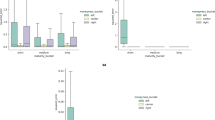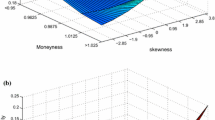Abstract
This empirical study is motivated by the literature on “smile-consistent” arbitrage pricing with stochastic volatility. We investigate the number and shape of shocks that move implied volatility smiles and surfaces by applying Principal Components Analysis. Two components are identified under a variety of criteria. Subsequently, we develop a “Procrustes” type rotation in order to interpret the retained components. The results have implications for both option pricing and hedging and for the economics of option pricing.
Similar content being viewed by others
References
Anderson, A., A. Basilevsky, and A. Hum. (1983). “Missing Data: A Review of the Literature.” In Rossi, P., J. Wright, and A. Anderson, Handbook of Survey Research, Academic Press.
Barone-Adesi, G., and R. E. Whaley. (1987). “Efficient Analytic Approximation of American Option Values,” Journal of Finance 42, 301-320.
Basilevsky, A. (1994). Statistical Factor Analysis and Related Methods, Theory and Applications. Wiley Series in Probability and Mathematical Statistics.
Bates, D. S. (1988). “Pricing Options under Jump-Diffusion Processes,”Working Paper, Rodney L. White Center for Financial Research.
Bates, D. S. (1996). “Jumps and Stochastic Volatility: Exchange Rate Processes Implicit in Deutsche Mark Options,” Review of Financial Studies 9, 69-107.
Black, F., and M. Scholes. (1973). “The Pricing of Options and Corporate Liabilities,” Journal of Political Economy 81, 637-654.
Brenner, M., and D. Galai. (1987). “On the Prediction of the Implied Standard Deviation,” Advances in Futures and Options Research 2, 167-177.
Buraschi, A., and J. C. Jackwerth. (1998). “Explaining Option Prices: Deterministic vs. Stochastic Models,” Working Paper, London Business School.
Christie, A. A. (1982). “The Stochastic Behavior of Common Stock Variances, Value, Leverage and Interest Rate Effects,” Journal of Financial Economics 10, 407-432.
Das, S., and R. Sundaram. (1998). “Of Smiles and Smirks: A Term-Structure Perspective,” Journal of Financial and Quantitative Analysis, forthcoming.
Derman, E., and I. Kani. (1998). “Stochastic Implied Trees: Arbitrage Pricing with Stochastic Term and Strike Structure of Volatility,” International Journal of Theoretical and Applied Finance 1, 61-110.
Dumas, B., J. Fleming, and R. E. Whaley. (1998). “Implied Volatility functions: Empirical Tests,” Journal of Finance, forthcoming.
Dupire, B. (1992). “Arbitrage Pricing with Stochastic Volatility,” Working Paper, Societè Generale Division Options, Paris.
Dupire, B. (1993). “Model Art,” Risk 6, 118-124.
Frachot, A., D. Jansi, and V. Lacoste. (1992). “Factor Analysis of the Term Structure: A Probabilistic Approach,” NER, Bank of France.
Franks, J. R., and E. S. Schwartz. (1991). “The Stochastic Behavior of Market Variance Implied in the Prices of Index Options,” The Economic Journal 101, 1460-1475.
Fung, K. H., and D. A. Hsieh. (1991). “Empirical Analysis of Implied Volatility: Stocks, Bonds and Currencies,” Working Paper, Fuqua School of Business, Duke University.
Gallant, A. R., H. Chien, and G. Tauchen. (1998). “Calibrating Volatility Diffusions and Extracting Integrated Volatility,” Working Paper, Duke University.
Hamilton, J. (1994). Time Series Analysis. Princeton University Press.
Harvey, A. (1993). Time Series Models. Second Edition, Harvester Wheatsheaf.
Harvey, C. R., and R. E. Whaley. (1991). “S&P 100 Index Option Volatility,” Journal of Finance 46, 1551-1561.
Heath, D., R. A. Jarrow, and A. Morton. (1992). “Bond Pricing and the Term Structure of Interest Rates: A New Methodology For Contingent Claims Valuation,” Econometrica 60, 77-105.
Heynen, R. (1994). “An Empirical Investigation of Observed Smile Patterns,” Review of Futures Markets 13, 317-354.
Hsieh, D. A. (1993): “Estimating the Dynamics of Volatility,” Proceedings of the Conference on Financial Innovation: 20 Years of Black/Scholes and Merton, Fuqua School of Business, Duke University, Durham, NC.
Hsieh, D. A. (1995). “Nonlinear Dynamics in Financial Markets: Evidence and Implications,” Financial Analyst Journal 51, 55-62.
Hull, J., and A. White. (1987). “The Pricing of Options on Assets with Stochastic Volatilities,” Journal of Finance 42, 281-300.
Jackson, E. (1991). A User's Guide to Principal Components. Wiley Series in Probability and Mathematical Statistics.
Johnson, H., and D. Shanno. (1987). “Option Pricing when the Variance is Changing,” Journal of Financial and Quantitative Analysis 22, 143-151.
Kamal, M., and E. Derman. (1997). “The Patterns of Change in Implied Index Volatilities,” Goldman Sachs, Quantitative Strategies Notes.
Ledoit, O., and P. Santa-Clara. (1998). “Relative Pricing of Options with Stochastic Volatility,” Working Paper, University of California, Los Angeles.
Litterman, R., and J. Scheinkman. (1988). “Common Factors Affecting Bond Returns,” Goldman Sachs, Financial Strategies Group.
Merton, R. C. (1976). “Option Pricing when Underlying Stock Returns are Discontinuous,” Journal of Financial Economics 3, 125-144.
Roll, R. (1984). “A Simple Implicit Measure of the Effective Bid-Ask Spread,” Journal of Finance 39, 1127-1139.
Rubinstein, M. (1985). “Non-Parametric Tests of Alternative Option Pricing Models,” Journal of Finance 40, 455-480.
Schmalensee, R., and R. R. Trippi. (1978). “Common Stock Volatility Expectations Implied By Option Premia,” Journal of Finance 33, 129-147.
Scott, L. O. (1987). “Option Pricing when the Variance Changes Randomly: Theory, Estimation and an Application,” Journal of Financial and Quantitative Analysis 22, 419-438.
Scott, L. O. (1997). “Pricing Stock Options in a Jump-Diffusion Model with Stochastic Volatility and Interest Rates: Applications of Fourier Inversion Methods,” Mathematical Finance 7, 413-426.
Stein, J. (1989). “Overreactions in the Options Market,” Journal of Finance XLIV, 1011-1023.
Taylor, S. J., and X. Xu. (1994). “The Magnitude of Implied Volatility Smiles: Theory and Empirical Evidence for Exchange Rates,” Review of Futures Markets 13, 355-380.
Velicer, W. (1976). “Determining the Number of Components from the Matrix of Partial Correlations,” Psychometrica 41, 321-327.
Wiggins, J. B. (1987). “Option Values under Stochastic Volatility,” Journal of Financial Economics 19, 351-372.
Xu, X., and S. J. Taylor. (1994). “The Term Structure of Volatility Implied by Foreign Exchange Options,” Journal of Financial and Quantitative Analysis 29, 57-74.
Author information
Authors and Affiliations
Rights and permissions
About this article
Cite this article
Skiadopoulos, G., Hodges, S. & Clewlow, L. The Dynamics of the S&P 500 Implied Volatility Surface. Review of Derivatives Research 3, 263–282 (2000). https://doi.org/10.1023/A:1009642705121
Issue Date:
DOI: https://doi.org/10.1023/A:1009642705121




